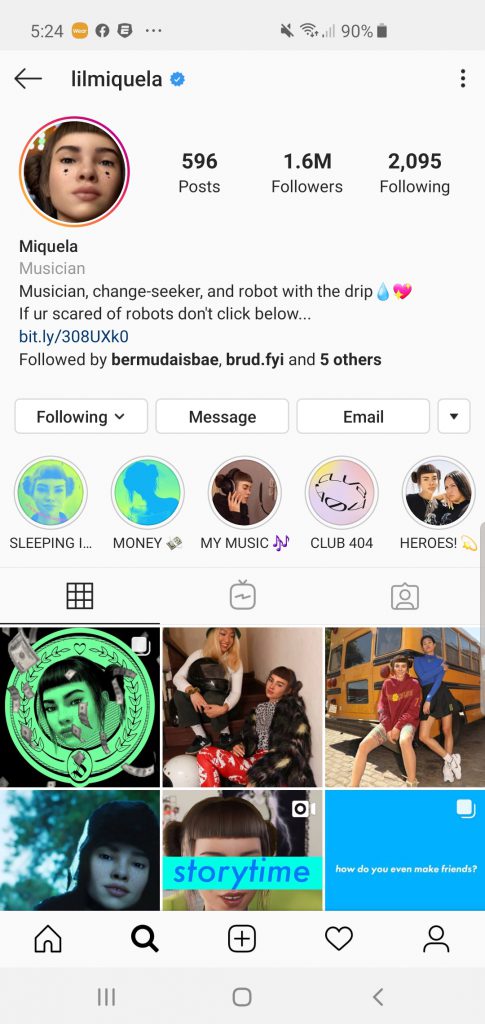Can Artificial Be Authentic?
Meet Miquela Sousa, or @lilmiquela on Instagram. Miquela is a 19-year-old musician from California known for her spunky attitude, compelling and relevant content, passion for activism, and as a “style icon,” she was invited to takeover Prada’s Instagram account during their 2018 show in Milan. With over 1.6 million followers, Miquela was named one of the “25 Most Influential People on the Internet” by Time Magazine. The catch, though – she’s not a person.
Miquela is an artificial influencer. She and her content are computer-generated imagery created in the likeness of a human influencer. Not only does Miquela regularly post on her social feed, but she also uploads content to Instagram Stories and even responds to comments in a very realistic fashion – all of which is curated by Brud, an LA-based startup company who is behind the creation and representation of lilmiquela as well as a number of other CGI (computer-generated imagery) influencers.
The development and interest in digital influencers like Miquela are the result of online behaviors which lead to the growth of brand utilization of consumers and celebrities as their advocates on social media. Influencer marketing is an important sector of media that continues to rise – in 2018, only 33% of retail marketers surveyed by eMarketer said they do NOT currently use influencers. Social media, especially Instagram, has natively evolved into a resource to help users make decisions and provide inspiration for their lives. Influencer marketing allows brands to deliver relevant information to eager audiences through the means of transparent endorsement.
In a recent Harmelin Media study, about 20% of adults polled confirmed they were first introduced to a brand/product through an online influencer. In addition, one in four women ages 18-34 confirmed that online influencers changed their opinions about a product. The trend comes along with the success of the D2C (direct to consumer) model, in which brands gain efficiencies by servicing their customers directly online. D2C shoppers are even more susceptible to influencer marketing, versus traditional brand shoppers, as they are more accustomed to this model and heavily reliant on online recommendations from peers, bloggers and celebrities who inform their purchase decisions.
Like many individuals who have gained recognition and a large following on the internet, Miquela has been sought out by high profile brands such as Calvin Klein, Samsung, and others to endorse their name/products in her content and beyond. However, what makes these partnerships different than that of a real-life influencer relationship is that Miquela is incapable of ever actually experiencing the brand/product or speaking authentically from personal experience about them. While fascinating in its unique and futuristic nature, when it comes to influencer marketing, artificial influencers are lacking the key ingredients for success: authenticity and human connection. Adam Wescott, a partner at Select Management Group, a talent management firm for influencers said, “I think the success of digital talent is in their engagement and their authenticity…And to what extent can you be authentic if ultimately you’re not even a real being?” To that note, controlled “authenticity” can never be real authenticity and therefore cannot possibly replicate the qualities of genuine human engagement.
When it comes to influencer marketing, perhaps the most valuable element that CGI lacks is the power of human connection. While Miquela may have mass reach, marketers should consider who her followers are and why they are following her. Reach is not everything, as individuals who have highly engaged audiences based on their specialized skills or niche interests are more likely to leave a greater impression than someone whose experiences are fabricated. Brands should invest in advocates who people trust and respect. CGI influencers lack authenticity and credibility as they cannot ever truly experience the brand themselves. Therefore, there isn’t anything they share with their audiences that can be trusted as true.
Despite the authenticity concerns, interest in CGI influencers is growing as many brands and even celebrities consider developing their own online digital personas based on the audience they are looking to reach. The ability to have complete control in every detail of the narrative is attractive and the creative limitations are nonexistent. The content is not bound by geography, culture, language, personality, etc. In addition, the ability to take risks is also appealing, not only because of the moldability of the content, but also because brands are able to push boundaries, since everything is fictional.
This is a dynamic trend that is constantly changing and evolving within social media. Should the native atmosphere and behaviors within the platforms shift in the future, it is not impossible for computerized personalities to be more influential to consumers. If the goal is merely to get people talking about your brand, partnering with CGI influencers does offer a compelling conversation starter. Then, the approach becomes “authentic” in its motives in utilizing the faux influencers for the purpose of offering opportunity for entertaining engagement with audiences, and thus the “connection” between the brand and the audience could still be impactful. After all, there are actual people responsible for creating Miquela, so there is still, in theory, a layer of human engagement behind the virtual mask.
At the end of the day, brands should be aware of the risks and uncertainties that accompany tapping into faux influencers as brand advocates. As society begins to embrace untouched photos and ask for a more real-life advertising experience, the use of CGI influencers may encounter some hurdles in the future. Ultimately, brands who rely on authenticity should consider their marketing goals before aligning with the world of artificial “people” and content.


